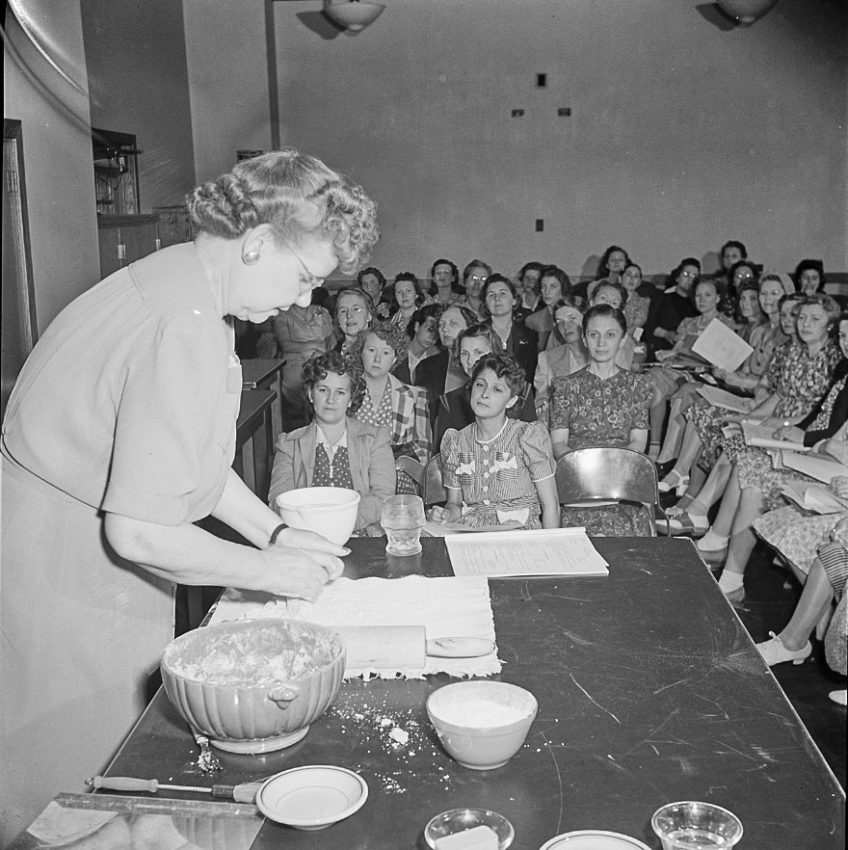Household and shopping tips, recipes, introductions of new residents, society items, news of women’s activities and organizations – these were some of the things covered on the women’s page(s) in the Greenbelt Cooperator. The Mrs. Greenbelt section, which appeared in the first issue of the Cooperator (published November 24, 1937) and ran through June 20, 1941, aimed to connect and inform women in the brand new town, nearly all of whom had arrived in Greenbelt knowing no one outside their own family. The new residents quickly had to get to know one another, develop relationships, choose leaders and form the organizations that were needed for life in the new town. The weekly newspaper could provide more information and details than postings on the town bulletin board in the Greenbelt Food Store or leaflets delivered to doorsteps.
One of the first concerns addressed was “When will the furniture arrive?” with the promised furniture, built especially for Greenbelt’s smaller homes, delayed again and again; some wives were waiting for the shipments to arrive before they moved to Greenbelt. By mid-December 1937, a bridge club and a choir for the Protestant Church Services were forming, and a group of mothers was making plans for both a kindergarten and a nursery school, having made a communitywide survey to get a count of the potential number of students: there were then 46 children of the right age for nursery school and 28 kindergarten-aged children whose parents were
willing to pay a nominal fee – not more than 50¢ per week – for their schooling. Two mothers – Dorothy East and Ruth Hayes – agreed to serve as teachers at the rate of 50¢ per child, and Theodora Murray, who chaired the mothers meeting, appointed a committee to find other local teachers, raise funds for equipment and negotiate with the town administration for classrooms.
Women were also involved in other aspects of civic life. Louise Endsley had been elected to a six-month term as secretary of the Greenbelt Citizens’ Association (GCA) at its inaugural meeting on November 8, 1937. Ruth Hayes was soon appointed chair of the GCA’s Social Welfare Committee, Arja Morgan was appointed to the Transportation Committee and Velma Brewer, Ruth Falls, Bertha Maryn and Dorothy Reamy were appointed to the Advisory Committee on Cooperatives. This last group of women visited nearby stores, purchased a variety of items to compare with similar items sold by the Greenbelt Food Store and made suggestions on prices, quantity and quality to the store management so they could make adjustments. Their efforts also led to the formation of consumer study groups that focused on such topics as product labels, meats (inspection and grading), milk (ordinance and regulations), eggs (grading), and food and drug laws. According to the Charter Day edition of the Cooperator (published June 1, 1938), “Greenbelt housewives agree with Mrs. Roosevelt when she says ‘I think that women as consumers should make it their business to know more about the quality of the goods which they buy, and to consider the conditions under which those goods are produced. If they do this, I feel sure that many changes could be effected which would be beneficial to the general public.’”
New committees kept springing up, spurred in part by women. In January 1938, Jessie Letkemann was elected to a committee – soon to become the Greenbelt Health Association – to draw up a plan for cooperative medicine, which Greenbelt residents had voted overwhelmingly in favor of (see Jeannette Connors’s article in the February 24, 2022, issue of the News Review to learn more about this). Also that month, Theodora Murray, chair of the GCA’s Dramatics Committee, called a meeting of residents interested in theater work, and then was elected president of the newly named Greenbelt Players.
Murray clearly had emerged as a leader in town, and had stood as a candidate in the first town council election in November 1937. Her platform: “Feels urgent need for recognition of women; is not suffragette; believes men do not know about problems of home making and marketing; sees need for feminine viewpoint,” as reported by the Cooperator (November 24, 1937) – did not get her elected, but another woman, Ruth Taylor, was elected to council in the next election in September 1938. By then, council candidates could tout their involvement in the various committees and organizations that had formed, and Taylor felt that women had an important contribution to make in community leadership. She was elected to a second term, but opted not to run again in the September 1941 council election. There then passed several years with no woman on the town council until Elizabeth Harrington was elected in 1947, and she became Greenbelt’s first woman mayor when she was the top vote-getter in the 1949 election. However, it would then be 20 years before the next woman was elected to council (Elizabeth Maffay in 1969). But, that’s another story ….

